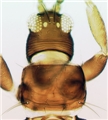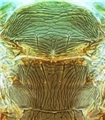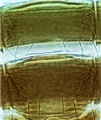Taeniothrips orionis
Recognition data
Distinguishing features
Female fully winged. Body brown, fore tarsi paler, antennal segment III yellow at base but light brown at apex; forewings light brown, base pale but extreme apex darker. Head longer than wide, constricted behind eyes with cheeks rounded; without sculpture between ocelli; two pairs of ocellar setae present, pair III longer than distance between compound eyes, arising between anterior margins of hind ocelli; pair II longer than side of ocellar triangle. Antennae 8-segmented; segments III � IV with sensorium forked. Pronotum with few discal setae, two pairs of long posteroangular setae; posterior margin with one pair of prominent setae medially arising in front of margin. Metanotum with reticulation equiangular on anterior half but longitudinal on posterior half; median setae at anterior margin; campaniform sensilla present. Forewing first vein with two setae on distal half; second vein with complete row of about 14 setae. Abdominal tergites with transversely reticulate sculpture medially; tergites VI � VIII with median setae about half length of tergite; tergite VIII with posteromarginal comb of long regular microtrichia. Sternites without discal setae.
Related and similar species
The genus Taeniothrips currently includes 44 species, although 21 of these are fossils, and one is an unrecognizable fragment from Australia (Mound, 1996). Of the remaining species, one is from Africa, one from western North America, three are European in origin, and the rest are from the tropics of Asia. The western North American species, T. orionis, is particularly similar to T. major Bagnall from the Himalaya region of northern India and Pakistan, both in the sculpture of the tergites and in having ocellar setae II longer than the side of the ocellar triangle.
Taxonomic data
Current valid name
Taeniothrips orionis Treherne
Original name and synonyms
Taeniothrips orionis Treherne, 1924: 86
Taeniothrips tahoei Moulton, 1927: 190
Taeniothrips pingreei Moulton, 1927: 191
Family placement
Thripidae, Thripinae
Biological data
Life history
Recorded from flowers at high altitudes (Bailey, 1957)
Host plants
Veratrum (Liliaceae), Polygonum (Polygonaceae), but with no recorded specificity.
Tospoviruses vectored
None
Crop damage
None
Distribution data
Area of origin
Western North America
Distribution
California, Oregon, Washington, Montana, Wyoming, Colorado.






